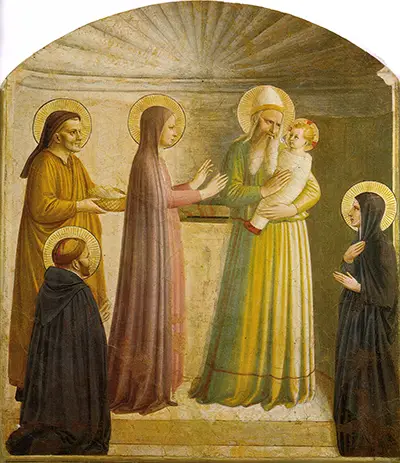Fra Angelico was one of the most important artists of the Early Renaissance in Florence. Born Guido di Pietro, his first paintings are noted in 1417, and it is around the same time that he became a novice at the Friary of San Domenico at Fiesole near Florence, taking the name of Fra Giovanni.
He remained there until 1439, when he moved to the city's Dominican Friary of San Marco, which was rebuilt with the support of Cosimo de Medici. Presentation of Jesus at the Temple is one of a series of frescoes completed here around 1440 to 1442. Fra Angelico worked on these, arguably his best-known works, with his assistants, choosing detailed subjects for the public areas, but reserving more restrained representations for the cells where the monks contemplated.
The muted colours of Presentation of Jesus at the Temple was produced for Cell 10, dominating in a way that is not intrusive to quiet thought and meditation. Fra Angelico was influenced by other artists of the Early Renaissance in Florence, especially the sculptor Ghiberti, and experimented with realism and volume to define subjects, and used linear perspective to emphasise space in the more thoughtful pictures.
The story is taken from St Luke's Gospel, when Mary and Joseph take the baby Jesus to the temple, as required for a first-born son. Joseph carries two turtle doves in a basket as an offering, with flames in the altar to emphasise the custom. The devout ageing Simeon receives the vision of the Messiah promised to him by God, as he holds the infant. Also in the picture are Saint Peter Martyr and Blessed Villana, a Florentine holy woman of the fourteenth century. The group conveys the serenity that is common in Fra Angelico's art, allowing him to portray ordinary people with dignity and respect.
The artist probably first worked under the monk Lorenzo Monaco, an important Florentine manuscript illuminator, miniaturist and painter at the time, with Fra Angelico's touches discernible in a choir book and elsewhere. After his death in Rome in 1455, he was described as the Angelic Painter due to the tranquillity of his style, and the name of Fra Angelico stuck. Although he has continued to be appreciated, it is only in recent years that his place in the development of European art has been properly recognised. Like Masaccio and others, Fra Angelico grasped the opportunities that came with the era, to pursue his radical understanding of perspective, and was always concerned with new trends. Presentation of Jesus at the Temple, which today still rests in San Marco, now the Museum of San Marco, is a perfect example of this.




